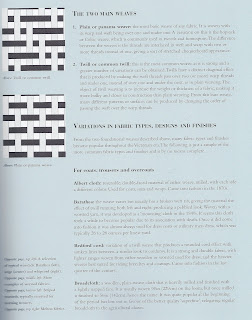Scottish Dress: Tweed Kilt Jacket
This Scottish jacket would be worn with a kilt or tartan trousers. The kilt or trousers would usually be made out of a 'Hunting Tartan.' This would normally be homespun cloth like 'Harris tweed' or 'Shetland Cloth'. The colour used in the tartan would then be used in the jacket. Compared to the lounge jacket this tweed kilt jacket is not to dissimilar in style of shape. It to is not extremely close fitting and it cut short. However, this jacket does have a side slit which is about 15.5cm long.
Obviously the detailing is different, for example on the pockets, which have three raised cords with button on the foot. This detailing is replicated on the sleeve cuffs. The button used would have been stag horn or leather. There is also three button down the CF line. Unlike the basic block, this jacket only has one dart and has a fuller appearance at the CF edge, though the jacket should not be too big at the CF line. The appearance is achieved by cutting away at the foot of the jacket. The shoulders are also more shaped on the Scottish block, as well as at the side seam, this will achieve a better shape.
Below is a 'Highland Fashion Plate' showing the tweed kilt jacket:
Scottish Dress: Evening Dress Kit Jacket
The Evening Dress Jacket would normally be worn by youths as evening dress, the fabric would be green or black with a waistcoat out if the same fabric. The kilt worn with this jacket would be made out if the finest tartan.
This Evening Dress Jacket isn't too dissimilar to the Tweed Jacket, however this would be cut to be much closer fitting, the lapel also has a point on it and the facing would be made out of silk. The buttons would also be different, normally silver with the crest of the clan, the braid would also be Russia tracing braid which would be used on the cuffs, pocket and the shoulder strap.
Below is a photo from the 1900's of a Scottish family the male is wearing the Evening Dress Kilt Jacket:
Uniform's: White Coat
The White coat was mostly worn by naval officers and unlike other jackets it would be made from white drill. The jacket has a step collar and would be fastened this four buttons. The side slit would be approximately 13cm. The pockets had no flap and were only patch pockets. for the officers a shoulder strap was added. This jacket differs depending on rank for the Midshipmen and Naval Cadets.
The block is quite similar to the block of the basic jacket, through with some key differences. The main is the shape of the CF line, the white coat has a straighter line unlike the basic black which has a nice sweeping curve. the lapel is different being a step on the coat and the pocket have a different arrangement. The coat still has two darts thought the second is straight, whereas on the basic block it is angled.
Below is a photo of a white coat of an officers ranking:
Service Dress Jacket: For Officers of the Rank of Colonel and Above
This Jacket block relates to most army regiments, however the style can be easily adapted. The regulated material colour for the jacket was khaki cloth, though for regiments such as 'The Brigade of Guards' a darker cloth was worn. Regimental status badges would be worn on the collar step.
This single breasted jacket has a step collar and lapel, it also has a breast pocket in patch style with a top flap, this is repeated in the bottom pocket. There would also be an inside pocket as well as an inside watch pocket.
This dress jacket has three darts instead of the two on the basic block. It also has an extra part on the CF line and on the back as slit. The side seam is more shaped to the male figure and the CF doesn't have the curved shape like on the basic block.
Below is a photo of officers on a bench wearing their uniform's:
Service Dress Jacket for Scottish Regiments: For Officers of the Rank of Colonel and Above
I love the way this pattern has different length and style shape at the bottom of the jacket for the different regiments. Unlike the British service jacket the Scottish CF line cuts away, not to dissimilar to the basic block. The style is usually divided at the waist seam which follows the side seam to the CF. Like the British service jacket it has two patch pockets, through for the Scottish Jacket the bottom pocket is much wider at the hip. The Jacket would have small regimental button not to dissimulate to the British.
Its similarities and differences aren't too dissimilar to the British service uniform stated above, with the exception on the CF line.
Below is a photo of the Scottish service jacket:


.jpg)










































